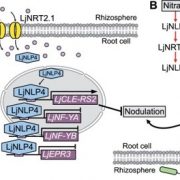Dual benefits of STOP1-NRT1.1 in response to acidic stress
Ye et al. investigate H+ tolerance mechanisms in Arabidopsis The Plant Cell (2021)
Plant Cell https://doi.org/10.1093/plcell/koab226
By Jia Yuan Ye and Chong Wei Jin
Background: Acid soils cover nearly half of the world’s arable lands. Application of urea-N and ammonium-N fertilizers markedly increases soil acidification due to proton (H+) generation from nitrification. High H+ concentrations in acid soils are highly rhizotoxic to most plants, thereby arresting their growth and productivity. Genetic manipulation of plants to optimize their biological processes and improve their adaptation to acid soils may be a cost-effective means of improving plant production in these soils. However, our current knowledge of H+ tolerance mechanisms is quite limited.
Question: Can we optimize plant biological processes to diminish the unfavorable impacts of H+ stress via the action of STOP1, the first key gene for H+ tolerance identified in plants that encodes a C2H2-type transcription factor?
Findings: We showed that in Arabidopsis roots, low pH enrichment of nuclear STOP1 directly activates NITRATE TRANSPORTER 1.1 (NRT1.1) expression by binding to its promoter and stimulating H+-coupled NO3– uptake by NRT1.1. This action enhances H+ depletion in the rhizosphere, creating a favorable rhizospheric pH for root growth and increasing N recovery from acid soils by plants. Therefore, STOP1-NRT1.1 is a key module by which plants improve nitrogen use efficiency, ensuring better plant growth under acidic conditions.
Next steps: We plan to elucidate how roots avoid an excess accumulation of H+ in the cytoplasm after stimulating H+-coupled NO3– uptake by NRT1.1. We also aim to clarify the basis of signaling leading to enrichment of nucleus-localized STOP1 in response to H+ stress.
Jia Yuan Ye, Wen Hao Tian, Miao Zhou, Qing Yang Zhu, Wen Xin Du, Ya Xin Zhu, Xing Xing Liu, Xian Yong Lin, Shao Jian Zheng, Chong Wei Jin. (2021). STOP1 activates NRT1.1-mediated nitrate uptake to create a favorable rhizospheric pH for plant adaptation to acidity. Plant Cell. https://doi.org/10.1093/plcell/koab226




